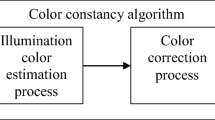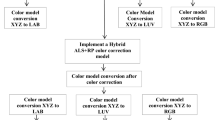Abstract
The qualities of color images captured by digital imaging devices are vulnerable to the scene illumination settings of a given environment. The colors of captured objects may not be accurately reproduced when the illumination settings are uncontrollable or not known a priori. This undesirable property can inevitably degrade the qualities of captured images and lead to difficulties in subsequent image-processing stages. Considering that the task of controlling scene illumination is nontrivial, color correction has emerged as a plausible post-processing procedure to efficiently restore the scene chromatics of a given image. In this study, a new color correction technique called the Saturation Avoidance Color Correction (SACC) algorithm is proposed to remove the undesirable effect of scene illuminants. Unlike most well-established color correction algorithms, the proposed SACC comprises a nonlinear pixel adjustment mechanism to avoid the saturation effect during the color manipulation process. A collection of color images including indoor, outdoor, and underwater images are used to verify the capability of SACC. Extensive experimental studies reveal that the proposed algorithm is preferable to some existing techniques because the former has a high capability to mitigate the color saturation issue and is able to produce corrected images with more pleasant visualization.
















Similar content being viewed by others
References
Abdul Ghani AS, Mat Isa NA (2015) Enhancement of low quality underwater image through integrated global and local contrast correction. Appl Soft Comput 37:332–344
Agarwal V, Gribok AV, Abidi MA (2007) Machine learning approach to color constancy. Neural Netw 20:559–563
Ayache N (1995) Medical computer vision, virtual reality and robotics. Image Vis Comput 13:295–313
Barnard K, Cardei V, Funt B (2002) A comparison of computational color constancy algorithms. I: methodology and experiments with synthesized data. IEEE Trans Image Process 11:972–984
Barnard K, Martin L, Coath A, Funt B (2002) A comparison of computational color constancy algorithms. II. Experiments with image data. IEEE Trans Image Process 11:985–996
Barnard K, Martin L, Funt B (2000) Colour by correlation in a three-dimensional colour space. In Computer Vision - ECCV 2000. vol. 1842, ed: Springer Berlin Heidelberg, pp. 375–389
Bianco S, Ciocca G, Cusano C, Schettini R (2008) Classification-based color constancy. In: Sebillo M, Vitiello G, Schaefer G (eds) Visual information systems. Web-based visual information search and management. Springer, Berlin, pp 104–113
Bianco S, Ciocca G, Cusano C, Schettini R (2010) Automatic color constancy algorithm selection and combination. Pattern Recogn 43:695–705
Bianconi F, Ceccarelli L, Fernández A, Saetta SA (2014) A sequential machine vision procedure for assessing paper impurities. Comput Ind 65:325–332
Buchsbaum G (1980) A spatial processor model for object colour perception. J Franklin Inst 310:1–26
Cardei V (2000) A neural network approach to color constancy. PhD Thesis, Simon Fraser Univ
Chen SY, Li YF, Zhang J (2008) Vision processing for realtime 3-D data acquisition based on coded structured light. IEEE Trans Image Process 17:167–176
Chen C-L, Lin S-H (2011) Formulating and solving a class of optimization problems for high-performance gray world automatic white balance. Appl Soft Comput 11:523–533
Cheng Y, Jafari MA (2008) Vision-based online process control in manufacturing applications. IEEE Trans Autom Sci Eng 5:140–153
Doulamis A, Doulamis N, Kollas S (2000) Non-sequential video content representation using temporal variation of feature vectors. Consum Electron IEEE Trans 46:758–768
Eberhardt M, Roth S, König A (2008) Industrial application of machine-in-the-loop-learning for a medical robot vision system – Concept and comprehensive field study. Comput Electr Eng 34:111–126
Faghih MM, Moghaddam ME (2014) Multi-objective optimization based color constancy. Appl Soft Comput 17:52–66
Finlayson G, Hordley S (2000) Improving gamut mapping color constancy. IEEE Trans Image Process 9:1774–1783
Finlayson GD, Hordley SD, Hubel PM (2001) Color by correlation: a simple, unifying framework for color constancy. IEEE Trans Pattern Anal Mach Intell 23:1209–1221
Finlayson GD, Hordley SD, Tastl I (2006) Gamut constrained illuminant estimation. Int J Comput Vis 67:93–109
Finlayson GD and Hubel PH (2000) White point estimation using color by correlation. U.S. Patent US6038339 A Patent
Finlayson GD, Trezzi E (2004) Shades of gray and colour constancy, presented at the Twelfth Color Imaging Conference: Color Science and Engineering Systems, Technologies, and Applications, Scottsdale, Arizona, USA
Gasparini F, Schettini R (2004) Color balancing of digital photos using simple image statistics. Pattern Recogn 37:1201–1217
Gijsenij A, Gevers T (2007) Color constancy by local averaging. In 14th International Conference on Image Analysis and Processing Workshops (ICIAPW 2007), pp. 171–174
Gijsenij A, Gevers T (2011) Color constancy using natural image statistics and scene semantics. IEEE Trans Pattern Anal Mach Intell 33:687–698
Gijsenij A, Gevers T, van de Weijer J (2011) Computational color constancy: survey and experiments. IEEE Trans Image Process 20:2475–2489
Huo J-y, Chang Y-l, Wang J, Wei X-x (2006) Robust automatic white balance algorithm using gray color points in images. IEEE Trans Consum Electron 52:541–546
Kim B-K, Park R-H (2010) Detection and correction of purple fringing using color desaturation in the xy chromaticity diagram and the gradient information. Image Vis Comput 28:952–964
Kurtulmuş F, Kavdir İ (2014) Detecting corn tassels using computer vision and support vector machines. Expert Syst Appl 41:7390–7397
Kwok NM, Shi HY, Ha QP, Fang G, Chen SY, Jia X (2013) Simultaneous image color correction and enhancement using particle swarm optimization. Eng Appl Artif Intel 26:2356–2371
Kwok NM, Wang D, Jia X, Chen SY, Fang G, Ha QP (2011) Gray world based color correction and intensity preservation for image enhancement. In 4th International Congress on Image and Signal Processing (CISP 2011), pp. 994–998
Lam EY (2005) Combining gray world and retinex theory for automatic white balance in digital photography. In Ninth International Symposium on the Proceedings of Consumer Electronics (ISCE 2005), pp. 134–139
Land E (1977) The retinex theory of color vision. Sci Am 237:108–128
Land EH, McCann JJ (1971) Lightness and retinex theory. J Opt Soc Am 61:1–11
Lee J-H, Yoo H-S, Kim Y-S, Lee J-B, Cho M-Y (2006) The development of a machine vision-assisted, teleoperated pavement crack sealer. Autom Constr 15:616–626
Montenegro J, Gomez W, Sanchez-Orellana P (2013) A comparative study of color spaces in skin-based face segmentation. In 10th International Conference on Electrical Engineering, Computing Science and Automatic Control (CCE 2013), pp. 313–317
Nammi S, Ramamoorthy B (2014) Effect of surface lay in the surface roughness evaluation using machine vision. Optik Int J Light Electron Opt 125:3954–3960
Nashat S, Abdullah A, Abdullah MZ (2014) Machine vision for crack inspection of biscuits featuring pyramid detection scheme. J Food Eng 120:233–247
Nikitenko D, Wirth M, Trudel K (2008) Applicability of white-balancing algorithms to restoring faded colour slides: an empirical evaluation. J Multimed 3:9–18
Quintana J, Garcia R, Neumann L (2011) A novel method for color correction in epiluminescence microscopy. Comput Med Imaging Graph 35:646–652
Rajamani V, Babu P, Rajinikannan M (2013) Optimal histogram modification scheme for image contrast enhancement using Otsu’s optimality method. In 2013 International Conference Green Computing, Communication and Conservation of Energy (ICGCE), Chennai, pp. 100–105
Raju A, Dwarakish GS, Reddy DV (2013) Adaptive plateau histogram equalization with mean threshold for brightness preserving and contrast enhancement. In 2013 I.E. Second International Conference on Image Information Processing (ICIIP), Shimla, pp. 208–213
Recky M, Leberl F (2010) Windows detection using K-means in CIE-Lab color space. In 20th International Conference on Pattern Recognition (ICPR 2010), pp. 356–359
Schechner YY, Karpel N (2005) Recovery of underwater visibility and structure by polarization analysis. IEEE J Ocean Eng 30:570–587
Stanikunas R, Vaitkevicius H, Kulikowski JJ (2004) Investigation of color constancy with a neural network. Neural Netw 17:327–337
van de Weijer J, Gevers T (2005) Color constancy based on the Grey-edge hypothesis. In IEEE International Conference on Image Processing (ICIP 2005), pp. II-722–5
Weng C-C, Chen H, Fuh C-S (2005) A novel automatic white balance method for digital still cameras. IEEE Int Symp Circuits Syst 4:3801–3804
Wirth Mm Nikitenko D (2010) The effect of colour space on image sharpening algorithms. In Canadian Conference on Computer and Robot Vision (CRV 2010), pp. 79–85
Yuan J-Z, Tian L-Y, Bao H, Huang J-H, Zhang R-Z (2009) llumination estimation combining physical and statistical approaches. In Third International Symposium on Intelligent Information Technology Application (IITA 2009), pp. 365–368
Zhang J, Yang Y, Zhang J (2016) A MEC-BP-Adaboost neural network-based color correction algorithm for color image acquisition equipments. Optik Int J Light Electron Opt 127:776–780
Zhuo L, Zhang J, Dong P, Zhao Y, Peng B (2014) An SA–GA–BP neural network-based color correction algorithm for TCM tongue images. Neurocomputing 134:111–116
Zhuo L, Zhang P, Qu P, Peng Y, Zhang J, Li X (2016) A K-PLSR-based color correction method for TCM tongue images under different illumination conditions. Neurocomputing 174(Part B):815–821
Acknowledgments
The authors would like to express their sincere gratitude to the associate editor and all reviewers who made great contributions to the improvement of this paper. This research was supported by the Fundamental Research Grant Scheme (“Formulation of a Robust Framework of Image Enhancement for Nonuniform Illumination and Low-Contrast Images”) of the Ministry of Higher Education of Malaysia.
Author information
Authors and Affiliations
Corresponding author
Appendices
Appendix A. Color correction results of the additional 18 test images from the GW, WP, gGW, MGE, GbC, DIR-CLAS, and SACC techniques
Appendix B. Comparison of the color correction results from the GW, WP, gGW, MGE, GbC, and SACC techniques based on the AMBE evaluation metric
Rights and permissions
About this article
Cite this article
Mohd Jain Noordin, M.N., Mat Isa, N.A. & Lim, W.H. Saturation avoidance color correction for digital color images. Multimed Tools Appl 76, 10279–10312 (2017). https://doi.org/10.1007/s11042-016-3620-y
Received:
Revised:
Accepted:
Published:
Issue Date:
DOI: https://doi.org/10.1007/s11042-016-3620-y







